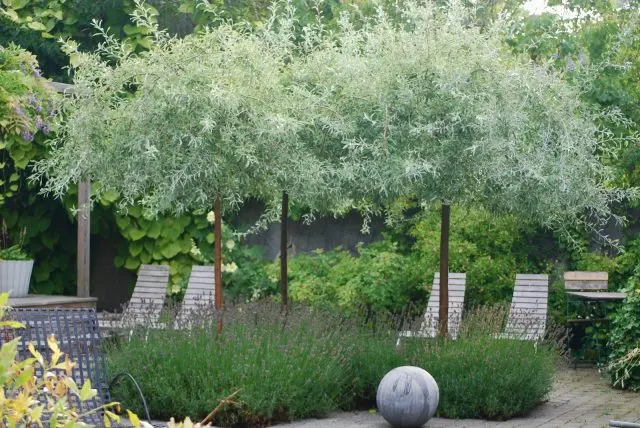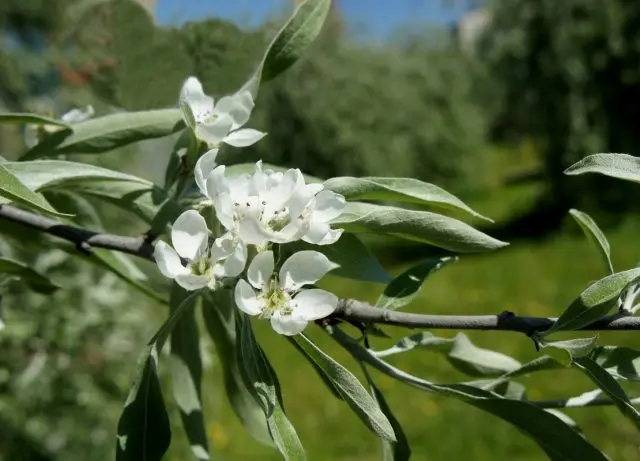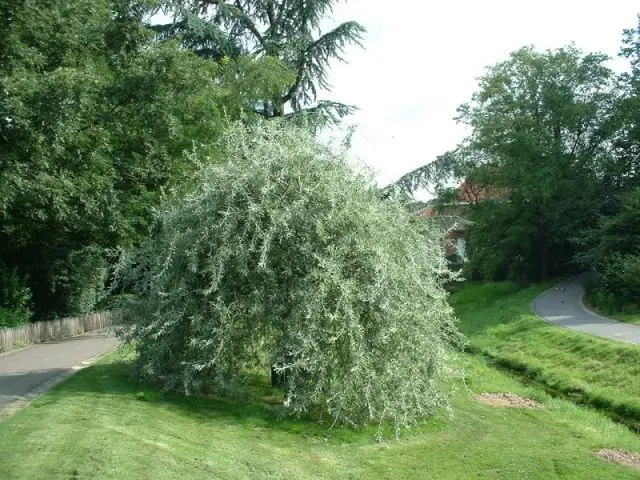Contents
Willow pear (lat. Pyrussalicifolia) belongs to plants of the genus Pear, family Pink. It was first described in 1776 by the German naturalist Peter Semyon Pallas. The tree gives an average growth of up to 20 cm per year. It is used in furniture production, for decorating garden and park areas, and also as a rootstock for cultivars of pears.

Description
Willow pear is a deciduous, light-loving tree. The crown is splayed, spreading, broadly ovoid. It reaches 4 m in diameter. Branches tending down and sides are prickly. New shoots with white tomentose omission. The trunk is usually somewhat curved. The height of the tree is 10-12 m. The bark of young plants has a reddish tint, but darkens with time, and cracks appear on it. The root system is deep. Gives usually lateral shoots.
The leaf plate is dark green in color, the bottom is light gray in color and slightly omitted. Leaf length 6-8 cm, width 1 cm, narrow-lanceolate shape. The petiole is short. The foliage is collected in bunches along the edges of the shoots.
The flowers are small in size, 2-3 cm in diameter. Each has 5 white petals 1×0,5 cm in size. Thyroid umbellate inflorescences consist of 7-8 flowers. The period of abundant flowering occurs in April-May.
The fruits are small, 2-3 cm in size. The shape is round and pear-shaped, during the period of technical maturity they are distinguished by a yellow-brown tint. The fruits ripen in September. The fruits of the willow pear are inedible.
The willow pear has a weeping shape called Pendula. The branches of this variety are thin, drooping. Attracts a tree with openwork foliage and early mass flowering. With the onset of autumn and until the first frosts, it is strewn with small fruits. It looks unusual: pears grow on a willow. The plant retains its decorative properties for 35-40 years.
Distribution
In the wild, the tree grows in eastern Transcaucasia, the Caucasus, and Western Asia. Willow pear is also grown in Azerbaijan, Iran, Turkey, Armenia. This species prefers rocky plains, slopes of mountains and hills. Often, the willow pear can be found in arid light forests, juniper and shilyak. Protected in protected areas. Quietly grows in salty, dense, waterlogged soils. The only requirements of the tree are abundant lighting and the absence of cold gusts of wind.

Use in landscape design
Willow pear is used to improve urban areas, parks, squares. Suitable for decorating home gardens and gardens. Looks spectacular due to the voluminous, spherical shape. The photo above shows white pear flowers along with long leaves – an original combination. In gardening art, a tree is used as a single-growing tree or as an element of a landscape composition. Ornamental willow pear can be used for hedges or edge plantings. Looks great in tandem with coniferous crops.
Feature of growing willow pear
The willow pear is a drought-resistant, frost-resistant tree that can grow in urban environments. Undemanding to the place of landing. However, it prefers moderately moist soils, the composition does not matter. The acidity level is neutral or alkaline.
Landing is carried out in autumn or spring. Saplings take one or two years. The recess is made 0,8×1 m in size. A fertile mixture of compost, sand and mineral fertilizers is poured onto the bottom. After the end of the procedure, the seedling is abundantly watered with water and the near-trunk circle is mulched.
In the future, the willow pear needs regular care.
- Watering is done 4-5 times per season. The volume of water for an adult tree is 30-40 liters.
- The willow pear is fed once every 1 years. However, if the soil is severely depleted, then annual recharge will be required. Fertilizer rate per 3 sq. m .: 1 g of superphosphate, 20 g of urea, 20-6 kg of compost, 8 g of potassium sulfate.
- The crown of an ornamental plant is formed naturally. In spring and autumn, mandatory sanitary pruning is carried out. Remove dry, broken, damaged branches.
- Obtaining unusual and interesting tree shapes is achieved by crown formation. To do this, you need tapestries with wooden gratings stretched in several rows. If you direct the central branches along an arched support, you will get an arch of trees.
- Willow pear is able to tolerate frosts down to -23 ° C. Belongs to the 5th climatic zone. Gardeners recommend covering boles and skeletal branches with paper or other heat-retaining material for the winter. To protect the roots from freezing, the near-stem circle is mulched with peat or hay. A layer 15-20 cm thick is required.
- The willow pear propagates by seeds and layering. The cuttings take root poorly.

Diseases and pests
Willow pear in its advantage is a wild plant, therefore it practically does not suffer from ailments and pests. For preventive purposes, the tree is regularly treated with solutions of insecticides and fungicides. Common diseases of ornamental wood include:
- Bacterial burn. Manifested in the blackening of branches, flowers, fruits. The first signs can be seen in the spring when the flowers turn brown. The bacterium Erwiniaamylovora activates this disease. A bacterial burn is treated with copper-containing preparations with the obligatory removal of the affected areas.
- Brown spot. It appears as red spots on the surface of young leaves. After the foci darken, occupying the entire area of uXNUMXbuXNUMXbthe leaf. The disease is caused by the fungus Entomosporium. The disease can be treated with fungicides. Fundazol, Topaz copes well with it.
- leaf curl occurs rarely in the willow pear, but it happens. Young foliage thickens, deforms, turns red-yellow and falls off. The fight against the disease consists in processing the willow pear with copper and iron sulphate until the leaves appear.
Conclusion
Willow pear is ideal for giving a decorative look to the garden. Landscape designers use wood to create arched compositions. The plant blooms profusely and looks beautiful from spring to late autumn.









